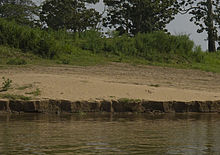
Back طمي Arabic Allüvi Azerbaijani Алювій Byelorussian Алювій BE-X-OLD Алувий Bulgarian जलोढ़ Bihari Al·luvió Catalan Naplavenina Czech Llifwaddod Welsh Alluvium Danish




Alluvium (from Latin alluvius, from alluere 'to wash against') is loose clay, silt, sand, or gravel that has been deposited by running water in a stream bed, on a floodplain, in an alluvial fan or beach, or in similar settings.[1][2][3] Alluvium is also sometimes called alluvial deposit.[4][5] Alluvium is typically geologically young and is not consolidated into solid rock. Sediments deposited underwater, in seas, estuaries, lakes, or ponds, are not described as alluvium.[1] Floodplain alluvium can be highly fertile, and supported some of the earliest human civilizations.[6]
- ^ a b Jackson, Julia A., ed. (1997). "alluvium". Glossary of geology (Fourth ed.). Alexandria, Virginia: American Geological Institute. ISBN 0922152349.
- ^ Glossary of Geological Terms. Geotech.org. Retrieved on 2012-02-12.
- ^ Geology Dictionary – Alluvial, Aquiclude, Arkose. Geology.Com. Retrieved on 2012-02-12.
- ^ Jackson, Julia A., ed. (1997). "alluvial deposit". Glossary of geology (Fourth ed.). Alexandria, Virginia: American Geological Institute. ISBN 0922152349.
- ^ Allaby, Michael (2013). "alluvium". A dictionary of geology and earth sciences (Fourth ed.). Oxford: Oxford University Press. ISBN 9780199653065.
- ^ Kidder, Tristram; Liu, Haiwang; Xu, Qinghai; Li, Minglin (July 2012). "The Alluvial Geoarchaeology of the Sanyangzhuang Site on the Yellow River Floodplain, Henan Province, China: THE YELLOW RIVER FLOODPLAIN, HENAN PROVINCE". Geoarchaeology. 27 (4): 324–343. doi:10.1002/gea.21411. S2CID 140587757.